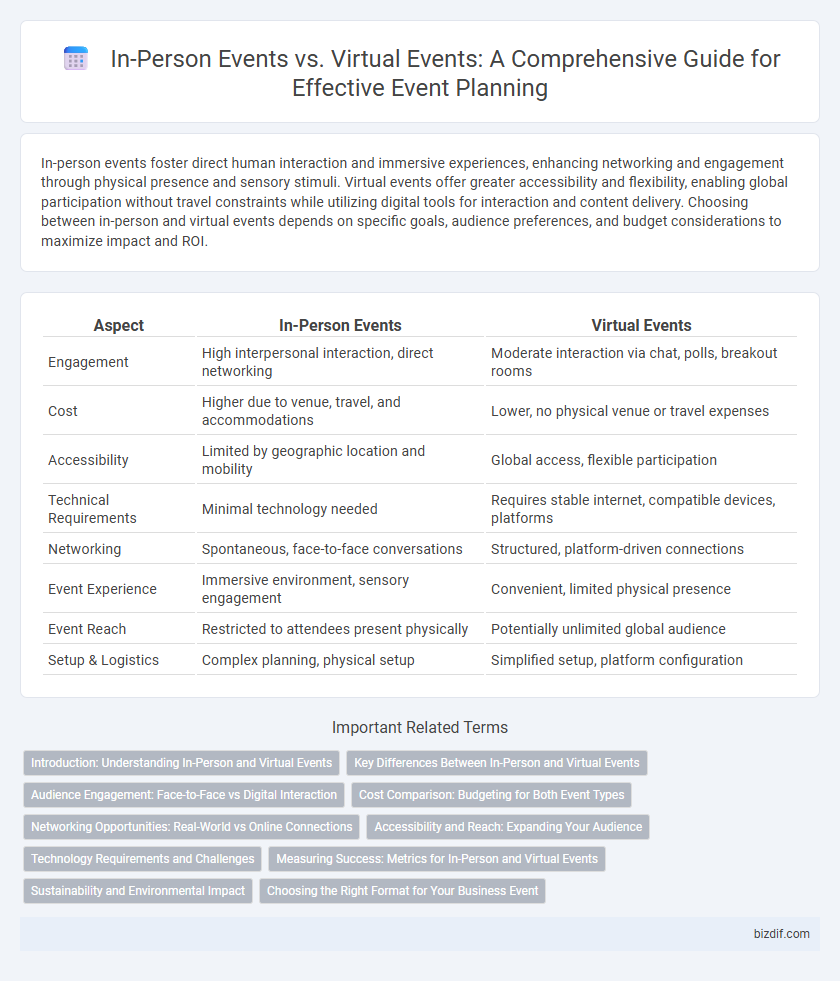In-person events foster direct human interaction and immersive experiences, enhancing networking and engagement through physical presence and sensory stimuli. Virtual events offer greater accessibility and flexibility, enabling global participation without travel constraints while utilizing digital tools for interaction and content delivery. Choosing between in-person and virtual events depends on specific goals, audience preferences, and budget considerations to maximize impact and ROI.
Table of Comparison
| Aspect | In-Person Events | Virtual Events |
|---|---|---|
| Engagement | High interpersonal interaction, direct networking | Moderate interaction via chat, polls, breakout rooms |
| Cost | Higher due to venue, travel, and accommodations | Lower, no physical venue or travel expenses |
| Accessibility | Limited by geographic location and mobility | Global access, flexible participation |
| Technical Requirements | Minimal technology needed | Requires stable internet, compatible devices, platforms |
| Networking | Spontaneous, face-to-face conversations | Structured, platform-driven connections |
| Event Experience | Immersive environment, sensory engagement | Convenient, limited physical presence |
| Event Reach | Restricted to attendees present physically | Potentially unlimited global audience |
| Setup & Logistics | Complex planning, physical setup | Simplified setup, platform configuration |
Introduction: Understanding In-Person and Virtual Events
In-person events foster direct human interaction, enhancing engagement through physical presence and real-time networking opportunities. Virtual events leverage digital platforms to reach global audiences, offering flexibility and cost-efficiency while utilizing tools like live streaming and interactive chat features. Understanding the distinct dynamics of these formats enables planners to tailor experiences that maximize attendee satisfaction and achieve event objectives.
Key Differences Between In-Person and Virtual Events
In-person events offer tangible networking opportunities and immersive experiences that virtual events often cannot replicate, enhancing attendee engagement through face-to-face interactions. Virtual events provide greater accessibility and cost-effectiveness by eliminating travel and venue expenses, allowing for a broader geographic reach and flexible participation. Key differences include the level of sensory engagement, logistical requirements, and potential scalability, with in-person events demanding physical presence and virtual events leveraging digital platforms for delivery.
Audience Engagement: Face-to-Face vs Digital Interaction
In-person events foster deeper audience engagement through direct face-to-face interactions, allowing for spontaneous networking, non-verbal communication, and immersive experiences. Virtual events rely on digital interaction tools like live chats, polls, and video streams to engage participants, offering convenience and broader accessibility but often lacking the emotional connection and immediacy found in physical gatherings. Measuring engagement in virtual formats requires analytics on attendee behavior and interaction rates to optimize content delivery and participation.
Cost Comparison: Budgeting for Both Event Types
In-person events typically incur higher costs due to venue rental, catering, travel, and accommodation expenses, while virtual events significantly reduce overhead by eliminating physical space requirements and associated logistics. Budgeting for virtual events often centers around platform licensing fees, digital marketing, and technology support, which are generally more scalable and predictable. Analyzing detailed cost components reveals that virtual events provide cost efficiency and flexibility, making them favorable for organizations with limited budgets or a global audience.
Networking Opportunities: Real-World vs Online Connections
In-person events facilitate spontaneous networking through face-to-face interactions, enabling participants to build trust and read non-verbal cues more effectively. Virtual events rely on digital tools like chat rooms and video breakout sessions, which can increase accessibility but may limit organic conversation flow. The choice between formats depends on goals for relationship depth and geographic reach in event planning.
Accessibility and Reach: Expanding Your Audience
In-person events offer tangible engagement but are often limited by geographic and physical accessibility constraints, restricting audience reach. Virtual events eliminate these barriers by enabling global participation regardless of location, enhancing inclusivity and audience size. Leveraging digital platforms for virtual events significantly expands reach and accessibility, making content available to diverse and remote attendees.
Technology Requirements and Challenges
In-person events demand high-quality audiovisual equipment, reliable internet connectivity, and on-site technical support to manage presentations, lighting, and sound systems effectively. Virtual events require advanced video conferencing platforms, robust cybersecurity measures, and seamless streaming technologies to ensure engaging and uninterrupted digital experiences. Both formats face challenges such as technical malfunctions, latency issues, and the need for adaptable technology solutions to accommodate diverse participant environments.
Measuring Success: Metrics for In-Person and Virtual Events
Measuring success in in-person events primarily relies on attendance numbers, participant engagement, and on-site feedback surveys to evaluate real-time interactions. Virtual events leverage metrics such as session duration, click-through rates, chat participation, and post-event analytics to gauge attendee interest and content effectiveness. Both formats benefit from tracking conversion rates and lead generation to assess overall return on investment and event impact.
Sustainability and Environmental Impact
In-person events typically generate higher carbon footprints due to travel, venue energy consumption, and physical waste, whereas virtual events significantly reduce these impacts by eliminating transportation and minimizing resource use. Studies show virtual events can decrease greenhouse gas emissions by up to 90% compared to traditional gatherings. Sustainable event planning increasingly favors hybrid models to balance engagement with environmental responsibility.
Choosing the Right Format for Your Business Event
Selecting the appropriate event format depends on business goals, target audience, and budget constraints. In-person events foster direct networking, immersive experiences, and relationship-building but require higher venue and logistical costs. Virtual events offer broader reach, cost-efficiency, and flexibility, supported by platforms with interactive features, making them ideal for global audiences and data-driven engagement tracking.
In-person events vs Virtual events Infographic

 bizdif.com
bizdif.com